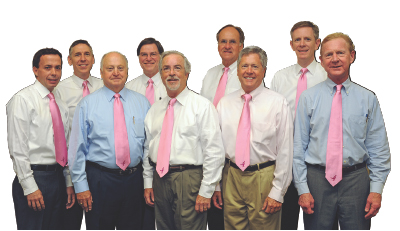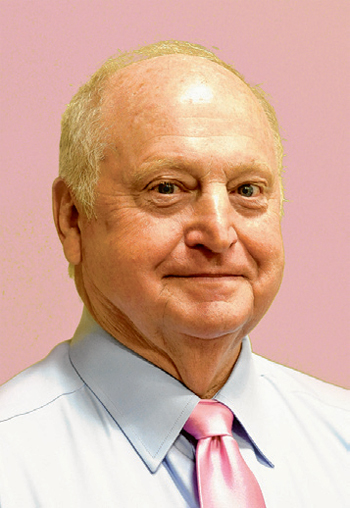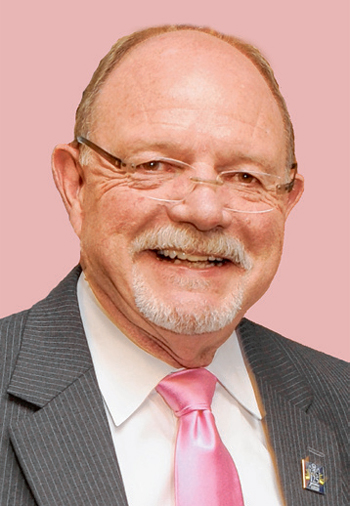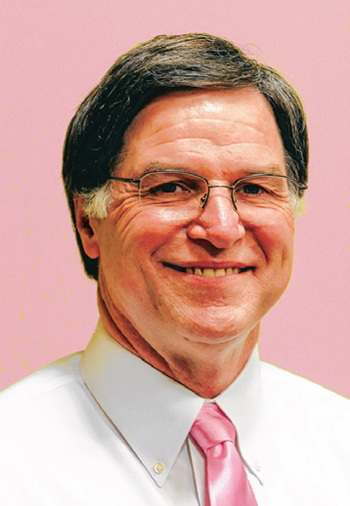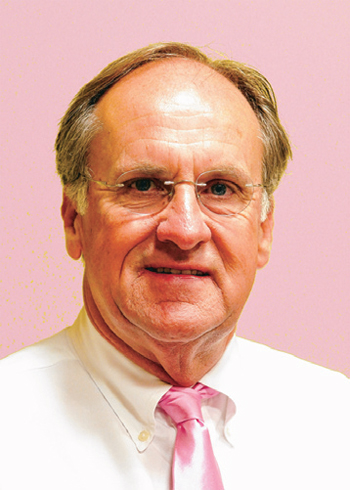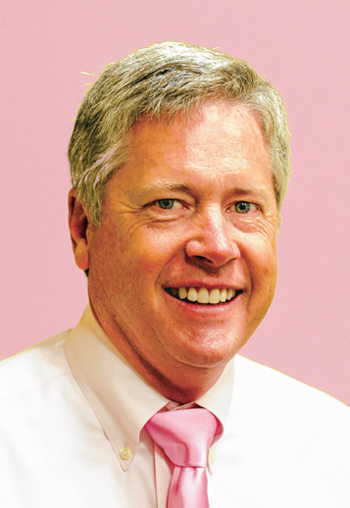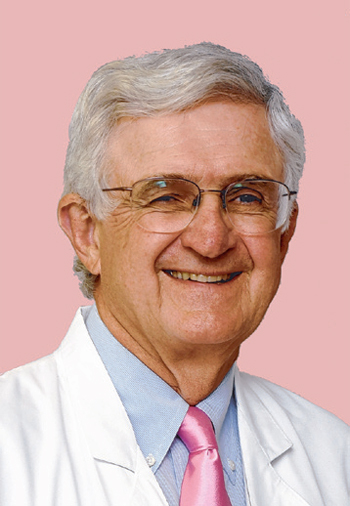Walking into Chancellor Roger Brown's office at the University of Tennessee at Chattanooga, it's obvious he's been a fan of "the pink" for many years. Plaques, pictures and medals from the annual Susan G. Komen Race for the Cure - held each year on UTC's sprawling downtown campus - cover his bookshelves and desk. While the school's commitment to host the 12-year-old race was in place before Brown's tenure, he is thrilled to continue the tradition, recently signing an agreement to keep the event on campus for the next 10 years. "I think it's one of the best community activities that this campus participates in," he says. And while he happily dons his t-shirt and shorts on race day, his involvement this year gets a bit dressier, namely with a silk necktie.
Brown is part of the inaugural "Dozen Pink Tie Guys," an idea hatched by Sarah Bowen, one of the founders of the Chattanooga Affiliate of Susan G. Komen for the Cure in 2000. In addition to a full-time job, she currently serves as president of the board of directors as well as head of the race's sponsorship and marketing and PR committees. Despite her hectic pace, she's managed to convince 12 local men to suit up in the fight against breast cancer.
Happily, Bowen didn't have to push too hard to recruit her team. Several men have personal ties to the disease, such as Randall Hebert, whose wife was diagnosed in 1994. As a CPA, Hebert helped "crunch the numbers" for starting the local affiliate as well as the first race. This interconnectedness struck Darrell Moore the first time he wore his tie.
"You don't find anyone who hasn't been touched by breast cancer, either through a family member or close friend," says the Parkridge Medical Center CEO. Wearing his tie about once a week, he generates enthusiastic support walking the halls of his hospital's cancer unit as well as curiosity from the general community. "For the most part it generates a very positive conversation, as well as the difficulties and challenges patients go through from detection to treatment."
The Pink Tie concept isn't entirely new - a handful of Komen affiliates across the country have attempted similar programs. But instead of asking the men to buy their tie at a local shop, Bowen wanted to step it up a notch. When a coworker turned her onto local tie designer Matt Wilson of Wilson & Bow, she approached him with the idea. "She asked if we would be willing to donate several pink ties in an existing design," recalls Wilson. "I said, 'How about we do a little better - a custom-designed tie with the Komen logo on the house?'"
Wilson's enthusiasm was no doubt fueled by his family tree. His aunt, grandmother and oldest sister have all been affected by the disease - his sister after the delivery of her third child. After several months of design and production, the ties arrived stateside into the hands of some enthusiastic businessmen. The hope is that wearing the brightly colored ties in their everyday lives will spark conversation, promoting breast cancer awareness as well as Komen's local Race for the Cure, held Sept. 25.
"Since its inception, Komen's Chattanooga affiliate has awarded more than $2.5 million in grants to local breast health organizations," says Pink Tie Guy Bill Aiken, partner at Chambliss, Bahner & Stophel, P.C. "Hopefully this will increase the profile of the local Komen race and underscore the importance of the event."
Fellow tie guy Dan Wolfe, general manager for Hamilton Place Mall, agrees. "While much has been done, there is still a need to bring awareness and raise money to hopefully one day find a cure. If I can do that by wearing a pink tie, I'm honored to do so."
Tie Talk: In Their Words
Randall Hebert
Partner with Henderson, Hutcherson & McCullough, PLLC
I get a lot of grief because as a CPA, I am probably more colorful than most. But people know that pink has a lot of significance to me. Last year when my wife Deb died from breast cancer we did a celebration of life service. People around the office were wondering what to wear since it wasn't a funeral; it was a celebration of life. One of my partners came up with the idea for everyone to wear something pink - men and women. So I definitely plan to incorporate the tie into my everyday wear. Hopefully it sparks a conversation and I get an opportunity to share just a few brief moments with somebody about what Deb's life was about and what Komen is all about. Hopefully you raise someone's awareness, maybe generate interest in the race and the opportunities there are to help us end this disease.
I think the goal is to eradicate breast cancer as a life-threatening illness and to get it to something that's manageable, almost like diabetes. You can still live a full life; you just have to treat it. In many ways Deb could be a case in point. On the one hand I could tell you 16 years wasn't enough, because it wasn't. But on the other hand, that's a lot of time. And there were a lot of new and great memories in those extra 16 years. Deb always had a strong appreciation for life, but in some ways it made her even better, more focused, more in tune with what she wanted and where she wanted to go in life. My main message would be to not let something like this get you down. Women by and large have always taken care of us, and we need a lot of it. But being a Pink Tie Guy is a way to recognize that we have a stake in this game too.
Lewis Dyer
President of Marshal Mize Ford
I've been involved with Race for the Cure through the dealership for about eight years, but when my sister-in-law, Karen Moore, developed breast cancer six years ago that started my involvement on a personal level. I remember when she first started treatment and went through the hair loss, selecting a wig and generally not feeling good. Then it came back about one year into remission and had spread to her liver and brain. I remember admiring her determination, the doctor saying he had no idea how she was still functioning and carrying on a conversation while her brain was eaten up with cancer. And I recall sitting in the room with her the night she passed away, thinking "Man, we've gotta find a cure somehow, some way." The first day I wore my tie no less than six people complimented it, and I reached down and showed them the emblem. I'm committed to wearing it as often as possible to bring awareness to the need to find a cure. I'm very optimistic that if we continue to support the research, there is a light at the end of the tunnel. I just hope we get there sooner than later to defeat this awful disease.
Roger Brown
Chancellor of University of Tennessee Chattanooga
My mother in law, who is almost 91, is a 50-year breast cancer survivor. I have always admired the fact that she went through this traumatic experience so long ago and didn't let it sideline her and went on to have a very long and successful career as a social worker. She's one of my personal inspirations.
I believe all of us men have been touched in our own lives by the experiences of our mothers, our sisters, other relations as well as close friends. This kind of solidarity of men with the issue of curing and preventing breast cancer is far more than social consciousness. It's part of our lives. This is a human issue and a human fight - not just a female fight. I think the area of breast cancer has enjoyed some of the best progress of any of the forms of cancer, so we just can't let up. We've got to keep moving.
Bill McCollum
COO at TVA
One of the first questions my wife Sylvia asked the oncologist was, 'What's the survival rate for my type of cancer and my stage?' He didn't hesitate to say don't pay any attention to anything you read about survival rates because they're based on people who were diagnosed at least five years ago, and because of all the research being done on breast cancer, treatments today are so much more advanced than they were five years ago that you can't even compare them. Thanks to the work of the Susan G. Komen Foundation, you literally have new treatments and advances coming out every year.
She's now a two-year survivor. I think it's easy to say, but the most important thing is to have a strong, positive attitude - believing that you're going to beat it and keep working through it. So much of being a Pink Tie Guy is to help people be more aware and think about regular testing, screening, and the right kind of health habits because of the importance of early detection. I think it also shows other men that it's okay to be involved, visible and supportive.
Rex Allen
CEO, The Pointe Center
When my wife, Debra, was diagnosed in 1999 the hormone therapy drug Herceptin wasn't available. Komen helped fast track its approval and it became available within three or four months of her diagnosis. Her diagnosis was not very good at all, but I believe the Herceptin extended her life by seven or eight years. We pursued treatment options all over the country, and some of them were available thanks to Komen. That's why I'm committed to this program.
When you're going through something like this, you're always looking forward. You can't solve what's happened so you just have to go out, take one day at a time and try to get the best treatments. It's like trying to win the ballgame, you're down 21 to nothing and you're trying to win the game. That's why organizations like Komen do such wonderful jobs because they allow you to look toward the future. Komen is this incredible network that creates strength for those people who are diagnosed with the disease. It creates a lot of comfort that there are other people out there fighting the same battle.
Ron Harr
Consultant and current chairman of the Chattanooga Area Chamber of Commerce
I hope when I'm wearing this tie it causes people to stop and ask about it, because it will give me an opportunity to talk about Komen, my wife's experience and the great things being accomplished for the disease. Linda is a 14-year survivor with a reoccurrence after 10 years. Her having endured twice being told she has breast cancer has made her an incredibly strong person about any kind of challenge that comes her way. I'm so proud of her. Hopefully she can be a positive role model so people will know that there is hope even when you get a bad diagnosis. Chattanooga is so blessed with caring people that come together and give their money for great causes in our community, and Komen is certainly one of them. The strides that have been made in breast cancer treatment and research are phenomenal and I think we owe a lot of that to Komen. I'm just happy they asked me to participate and to play a small part. I just hope I don't spill gravy on my new tie.
Dr. Phillip Burns
Chairman of the Department of Surgery, University of Tennessee and chairman of the board of University Surgical Associates
Aside from absolute survival rates, the research Komen has funded has made a difference in terms of better defining which type of treatment you give to each patient. It's changed it from a shotgun to a rifle approach. It's also had a huge impact on public awareness. If you compare now to 30 years ago, there's a radical difference in the number of women we treat in the earlier stages of breast cancer. That's why Pink Tie is such a great idea. I've had pink shirts in my closet for 30 years, but the tie in particular with the nice logo - it's going to draw attention. And I think sometimes all it takes is a brief snippet like that to get people to think about things like early detection, self-exams and mammography. Maybe it will mobilize some men to think more about it in terms of their wives.

